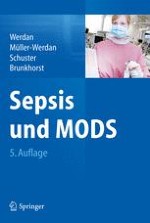Zusammenfassung
Neurologische Komplikationen der Sepsis sind häufig. Die septische Enzephalopathie mit dem klinischen Bild des Delirs ist ein Frühsymptom der Sepsis, zeichnet sich durch Vigilanzschwankungen und Verwirrtheit aus und bedingt im Langzeitverlauf kognitive Leistungsminderungen. Die Critical-illness-Polyneuropathie (CIP) und die Critical-illness-Myopathie (CIM) sind Entitäten muskulärer Schwäche bei kritisch kranken Patienten. Alle neurologischen Komplikationen sind mit Verlängerung der Beatmungszeit, der Dauer des Krankenhausaufenthaltes, der Rehabilitation und erhöhter Mortalität vergesellschaftet. Die frühe und leitliniengerechte Sepsistherapie ist das Mittel der Wahl zur Verhinderung von sepsisassoziiertem Delir, konsekutiven kognitiven Einschränkungen, CIP und CIM. Obwohl es bislang keine spezifische Therapie gibt, ermöglicht die frühe Diagnose aber insbesondere supportive Maßnahmen. Die regelmäßige neurologische Evaluierung von Sepsispatienten ist deshalb unverzichtbar.











